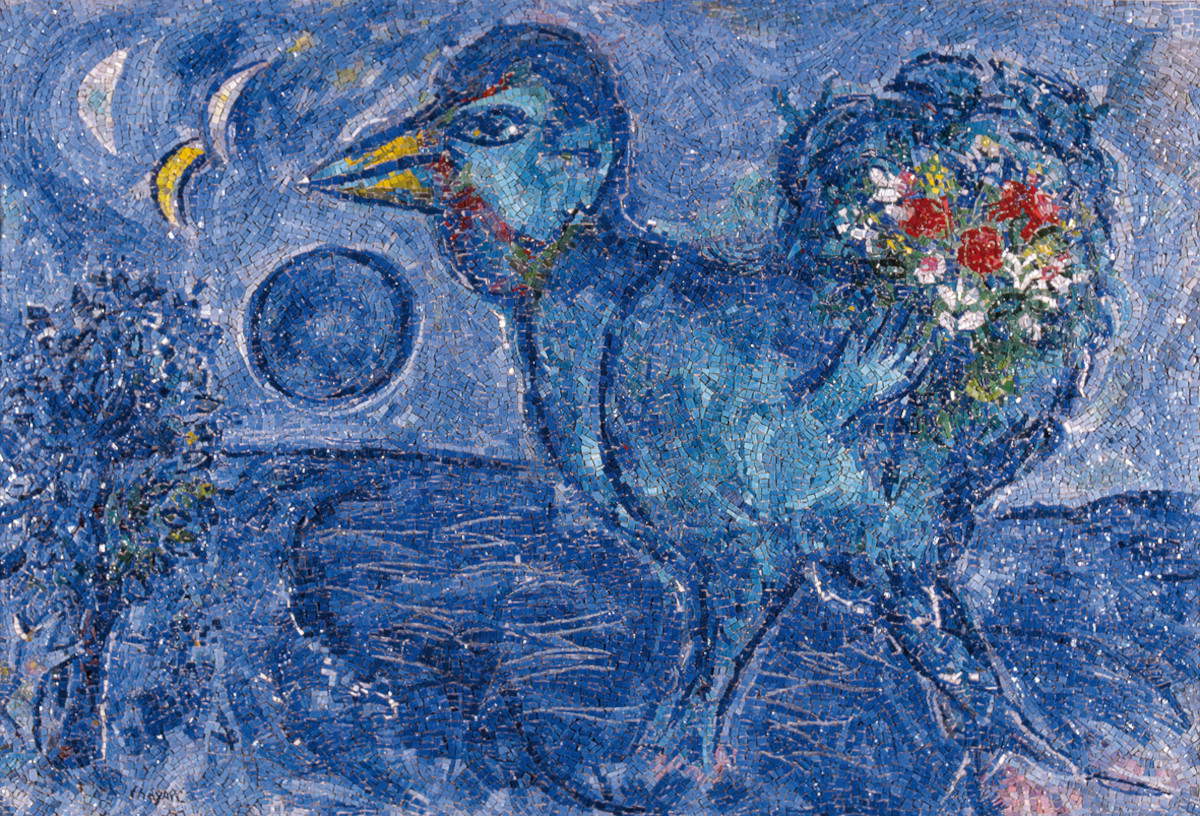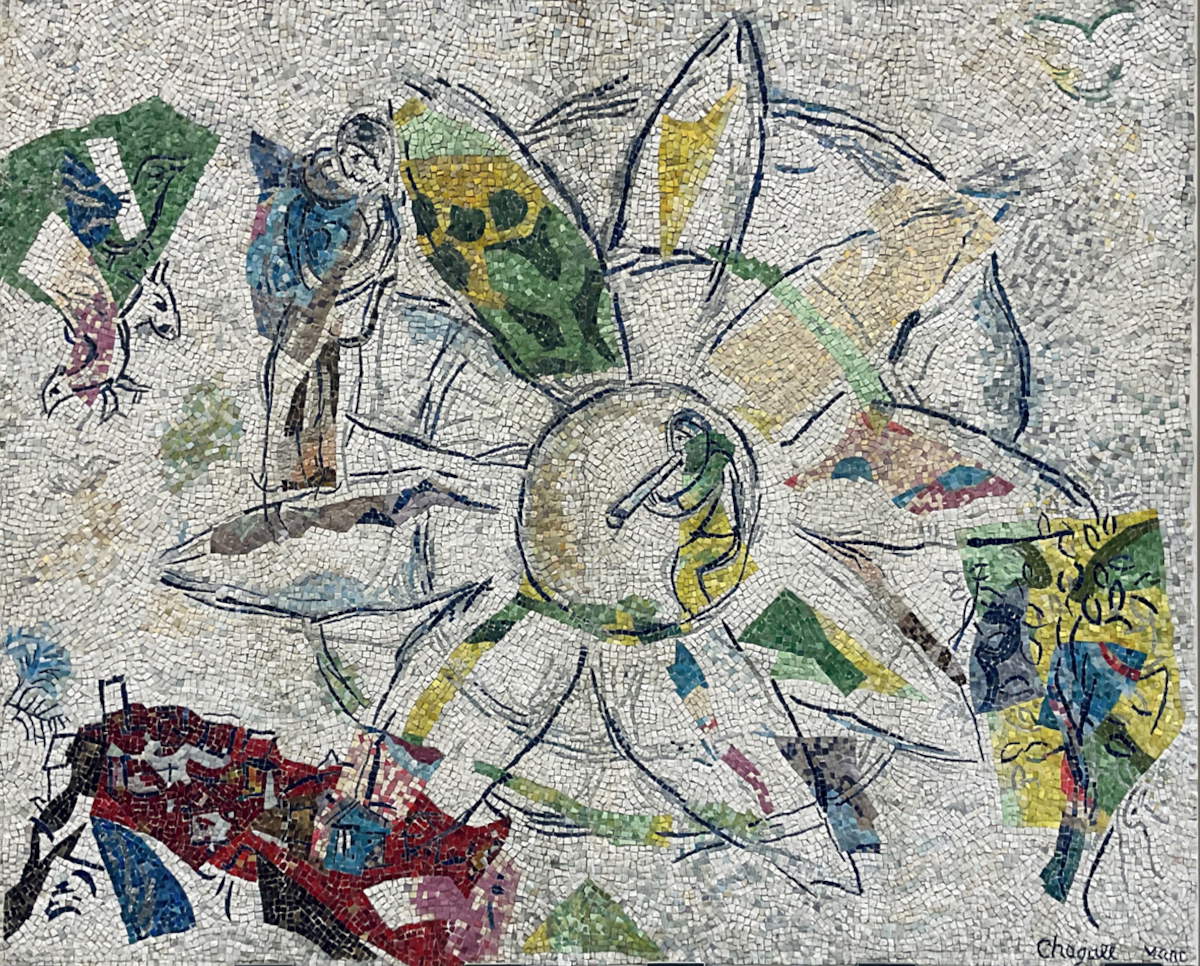From October 18, 2025 to January 18, 2026, the MAR - Art Museum of the City of Ravenna hosts Chagall in Mosaic. From Project to Work, the first exhibition entirely dedicated to the relationship between Marc Chagall and mosaic art.
The exhibition inaugurates the 9th Ravenna Contemporary Mosaic Biennial, which from October will animate the city for three months with installations, exhibitions and widespread events. An event aimed at celebrating a millennial artistic language, capable of renewal and dialogue with the contemporary. The Biennial is conceived, organized and supported by the City of Ravenna - Department of Culture and Mosaic, with contributions from the Emilia-Romagna Region, Marcegaglia and the Fondazione del Monte di Bologna e Ravenna.
The exhibition is a co-production between the Musée national Marc Chagall in Nice and the MAR; it is curated by Anne Dopffér (director general of the Musées nationaux du XXe siècle des Alpes-Maritimes), Gregory Couderc (scientific director of the Nice museum), Giorgia Salerno (curator of the MAR) and Daniele Torcellini (artistic director of the Biennale), with support from Archives & Catalogue raisonné Marc Chagall.
The exhibition represents a key moment in the appreciation of the link between Chagall and mosaic, born in the 1950s in direct dialogue with Ravenna and its master mosaicists. A still little-known aspect of the artist’s work. A first stage of the review had already been held in Nice between May and September 2025, as part of the in-depth program the French museum devotes to the different techniques explored by Chagall.
Chagall’s connection with Ravenna began in 1954, when the artist became fascinated by the city’s Byzantine mosaics. The following year, at the invitation of Giuseppe Bovini, director of the National Museum of Ravenna, and through the intermediary of art historian Lionello Venturi, he participated in the Exhibition of Modern Mosaics, a nationwide event featuring the collaboration of Ravenna mosaicists with internationally renowned artists. Participants included names such as Afro, Capogrossi, Guttuso and Vedova. For Ravenna, Chagall created his first mosaic, Le Coq bleu, now among the best-known works in the collection of the city’s Museum of Art. This very work introduces the exhibition itinerary, presented in both mosaic versions created by Antonio Rocchi and Romolo Papa, alongside the original sketch.

The exhibition’s itinerary winds through fourteen monumental projects conceived by Chagall between 1958 and 1986, from international institutions and collections in France, the United States, Israel and Switzerland. Sketches, gouaches, drawings and mosaics tell the story of the artist’s creative process, flanked by paintings, engravings and lithographs that complete the picture of his evolution. Central was the collaboration with Ravenna mosaicist Lino Melano and his wife Heidi, and since the 1970s with Michel Tharin.
Prominent among the masterpieces on display is, for the first time in Italy, the large mosaic Le Grand Soleil (1965-1967), created with Lino Melano. A work intimately linked to the artist’s private life-it was given to his wife Valentina for their residence in Saint-Paul-de-Vence-returns to view after decades thanks to a careful restoration by Benoit and Sandrine Coignard, promoted and supported by the MAR.
The exhibition traverses some of Chagall’s best-known mosaic works: from Les Amoureux (1964) for the Fondation Maeght to Le Char d’Elie (1973) at the Musée de Nice, to Le Cour (1964), presented here through an immersive installation. This is followed by Le Message d’Ulysse (1968) for Faculty of Law in Nice, Orphée (1969-71) now at the National Gallery in Washington, DC, Le Mur des Lamentations (1965-66) for the Knesset in Jerusalem, and The Four Seasons (1974) for the First National Bank in Chicago.
The exhibition also devotes space to Ravenna mosaicists Romolo Papa, Antonio Rocchi and Lino Melano, who were confronted with Chagall’s work and collaborated with him. It is an in-depth look at the relationships between the Mosaic School of the Academy of Fine Arts in Ravenna, the Mosaicists Group and the École d’Art Italien in Paris directed by Gino Severini, as well as the intense collaboration between Chagall and the Ravenna mosaicist Lino Melano, with whom he worked on many of his mosaic productions.
A catalog published by Silvana Editoriale also accompanies the exhibition.
Hours: Tuesday through Saturday from 9 a.m. to 6 p.m.; Sundays and holidays from 10 a.m. to 7 p.m. Closed Mondays.

 |
| At the MAR in Ravenna, the first exhibition entirely devoted to the relationship between Chagall and mosaic art |
Warning: the translation into English of the original Italian article was created using automatic tools. We undertake to review all articles, but we do not guarantee the total absence of inaccuracies in the translation due to the program. You can find the original by clicking on the ITA button. If you find any mistake,please contact us.